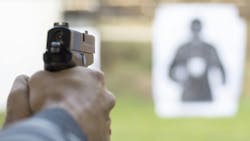If you are a hunter, you inevitably read or see a report about a hunter mistaking and shooting another animal for a deer. I live in Wisconsin, a state known for dairy cows, and it seems every deer season someone confuses a several thousand-pound black and white spotted bovine for a 150-pound brown Bambi.
In law enforcement, mistake-of-fact (MOF) shootings account for up to a quarter of all officer-involved shootings. Common factors that are attributed to MOF shootings are low light, distance, and suspect behaviors and actions. Regardless of what may have contributed to MOF shootings, the possible variables that cause them are often viewed as excuses by the media and the public. Now we are seeing prosecutors criminally charging officers when they fire their weapons in these situations.
The fact that 25% of all police shootings can be MOF should be a wake-up call to law enforcement leaders and trainers alike. There are consultants and trainers who have made a handsome profit from defending MOF shootings in the classroom and courtrooms, trying to apply concepts of action vs. reaction times, officer mindset, body mechanics and dynamics, and a lot of other “science.”
A true scientist knows that science begs for more science, which reminds me of the time I once consulted a case in which officers fired multiple times at an unarmed subject, killing him. An argument using reaction time was brought up that the officers only had a fraction of a second to make a life-or-death decision to shoot. I used the same reaction time figures to demonstrate that the same officers therefore had the time to decide not to shoot and stop shooting. Science begs for more science. The room full of attorneys never thought about that, and I am sure they were not pleased their consultants never thought their own science would be used against them.
Instead of trying to defend MOF events, and I will be the first one in line to say there are some examples of MOF events that deserve and need defending primarily due to the suspect’s intentional behaviors, it should be time that agencies, trainers, and consultants begin to work collaboratively to prevent them. Law enforcement should not accept that up to a quarter of shootings will be MOF, that number is way too high and does nothing to show the advancements made in police training over the years.
There are three simple concepts that should be used to help reduce MOF shootings. The first is to engrain the concept of the officer creating more distance in any potential deadly force event. Distance is an officer’s friend as it not only grants the officer a higher degree of safety by measurement of feet, but it also grants time for threat assessment and de-escalation. The second reduction method is the use of cover. Police trainers have been practicing cover concepts for years but we continually see officers on video abandoning cover or ignoring it, in order to get closer to the suspect. Why? Because cover is often talked about but rarely trained in practical training exercises. Third is increased weapons lighting. Every department should require a mounted light system on all duty guns and require them to be activated in all times of day, period.
These concepts must be instilled and practiced not only in basic training but also in ongoing training as well. I still see many agencies whose firearms training consisting of only qualification courses, with no scenario-based or isolation exercises that focus on creating distance, using cover, and increasing lighting. These agencies are not only begging for a MOF event to happen, but they are opening themselves up to officers being criminally prosecuted and a civil suit to follow. Any police firearms training program that does not practice distance, cover, and lighting requirements is deficient in modern-day law enforcement.
A half-awake hunter who shoots a heifer instead of a whitetail will surely be fined and ridiculed for the remainder of his or her hunting days. An officer who shoots a person who is not armed may endure trauma, litigation, discipline, and a potential prison sentence. We owe it to our officers and the public they serve to reduce that 25% statistic of mistake-of-fact shootings. It’s unacceptable, but it can be mitigated with the proper leadership and training.
About the Author
Brian Landers is a former law enforcement officer and current professor of criminal justice. He also serves as an expert consultant and witness for police use of force incidents throughout the United States. He can be reached at [email protected]



